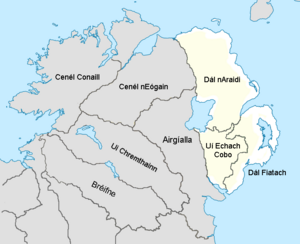Dál Fiatach facts for kids
| Dál Fiatach |
|||
|---|---|---|---|
| Country: | Quick facts for kids Ireland |
||
| Parent House: | Ulaid-Dáirine | ||
| Titles: | *Kings of Emain Macha
|
||
| Founder: | Fiatach Finn | ||
| Final Ruler: | Ruaidrí mac Duinn Sléibe | ||
| Current Head: | none | ||
| Founding Year: | 1st century AD | ||
| Dissolution: | 13th century AD | ||
Dál Fiatach was an important family group and kingdom in ancient Ireland. They lived in the northeast, in what is now eastern County Down. They were a powerful ruling family in the larger kingdom of Ulaid. Their main city was Dún Lethglaise (today called Downpatrick). From the 9th century, their main religious center was Bangor Abbey. The Dál Fiatach kingdom lasted through the Middle Ages. It ended in the 13th century when Normans took over their lands.
Who Were the Dál Fiatach?
The Dál Fiatach family claimed to be descendants of Fiatach Finn, a legendary king. He was said to be a King of Ulaid and a High King of Ireland. Scholars believe they were related to ancient groups like the Voluntii and Darini. These groups were mentioned by a writer named Ptolemy long ago. They might also be linked to the Dáirine and Corcu Loígde families. Some also believe they were related to the Osraige and, more distantly, the Dál Riata.
The Dál Fiatach were considered the true historical Ulaid people. However, their power lessened in the 7th century. Another group, the Dál nAraidi, then claimed to be the "true Ulaid." They tried to link themselves to the famous heroes of the Ulster Cycle stories. The Dál Fiatach chose to stress their links to the Clanna Dedad of Munster instead.
Important Dál Fiatach Kings
Many Dál Fiatach kings also became King of Ulster (Ulaid). However, they did not always hold this title. The Dál nAraidi also had several powerful kings. Some of the most important Dál Fiatach kings included:
- Muiredach Muinderg (died 489)
- Báetán mac Cairill (died 581)
- Fiachnae mac Demmáin (died 627)
- Bécc Bairrche mac Blathmaic (died 718)
- Fiachnae mac Áedo Róin (died 789)
- Niall mac Eochada (died 1063)
A smaller branch of the Dál Fiatach ruled Lecale. This is a peninsula south of their capital, Dún Lethglaise. Dún Lethglaise was not only a royal center but also an important religious site. Later, from the 9th century, Bangor Abbey became the main religious place supported by the Dál Fiatach kings.
Dál Fiatach Family Branches
Here are some of the groups and families that were part of or linked to the Dál Fiatach:
- Dál mBuinne: Also known as the Muintir Branáin. They lived near Moylinny in County Antrim.
- Leth Cathail: This was an offshoot of the Dál Fiatach family. They lived in the area known today as Lecale, County Down.
- Uí Blathmaic: Their land was in the northern part of the Ards area.
- Uí Echach Arda: They were based in the Ards Peninsula.
- Mac Duinnshléibhe: This name means "brown mountain." Today, it is seen as MacDonlevy or Dunleavy.
- Ó hEachaidh: This means "son of Aghy." Modern versions include Haughey and Hoey.
See also


